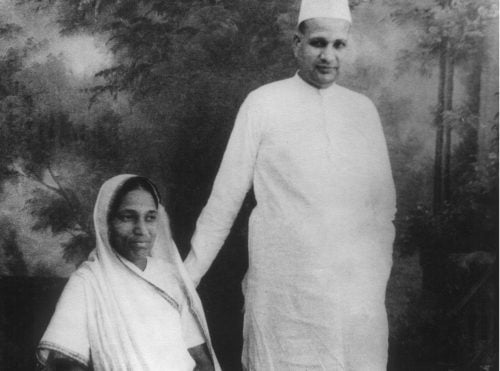Smt. Janki Devi Bajaj was a strong advocator of the Gandhian way of life. During the nationalist movement of India, she actively participated in the Swadeshi movement. She discarded foreign clothes and adapted to a Gandhinian way of lifestyle. She was born on 7th January, 1893 into a wealthy Vaishnav-Marwari family of Jaora in Madhya Pradesh. Despite being from a well to do family and later on being married into another, she was not hesitant even once to sacrifice her luxurious life in order to participate in India’s struggle for independence. A woman with a persona of her own, Janki Devi helped in the liberation and upliftment of many other women. She made immense efforts to eradicate discriminatory customs of ‘untouchability’ and the purdah system.
Early Life
At the age of around 12, Janki Devi was married to Jamnalal Bajaj in the year 1902. After her marriage, she shifted from Madhya Pradesh to Wardha, in Maharashtra. Although due to the contemporary social beliefs and traditions of those times, Janki didn’t receive any proper schooling, still she was very keen on reading and writing. Looking at this, her husband Jamnalal gave her homeschooling and even helped her become aware in life.
Maharashtra. Although due to the contemporary social beliefs and traditions of those times, Janki didn’t receive any proper schooling, still she was very keen on reading and writing.
Mahatma Gandhi played the role of a very influential figure in both Janki Devi and her husband’s life. Both of them were inspired by his efforts towards independence of their country and also towards social upliftment. Inspired by Gandhi, Jamnalal in the quest to find his right personality sacrificed his luxurious life in 191, and adapted the Gandhian way of life. Janki Devi too joined her husband in this journey. Hence, she became one of the women in India to work with Gandhiji towards social upliftment.
A Step Towards Social Upliftment
Janki Devi’s list of accomplishments began with relinquishing gold ornaments. She sacrificed all her gold ornaments to adopt the simplistic way for life. Then in 1919, Janki Devi took a revolutionary step and gave up the ‘purdah’—something which was considered as a symbol of “social grace” and “aristocracy”. She then motivated many other women to do the same; giving up the purdah became a symbol of courage, self-independence and unity.

Then in the year 1921, following the steps of Mahatma Gandhi, Janki Devi too joined the wave of the Swadeshi movement. At the age of 28, she burnt all her foreign clothes and adapted Khadi. She spun the Khadi herself and even taught many other women how to use ‘Charkha’. She actively encouraged women to join the Swadeshi movement. With her efforts, she tried to bring a sense of self-sufficiency and courage to speak against injustice in the lives of many Indian women at that time.
With her efforts, she tried to bring a sense of self-sufficiency and courage to speak against injustice in the lives of many Indian women at that time.
Her efforts towards social upliftment only grew bigger. On 17th July, 1928 for the first time in India Harijans were allowed inside a temple. Janki Devi along with her husband opened the doors Lakshminarayan Temple at Wardha to everyone, irrespective of their caste.
After continuously working for freedom struggle, there was nothing to stop Janki from progressing towards an emancipated society. Starting by liberating herself, Janki continuously moved towards liberating others. At the time, when women weren’t even allowed to step out of their houses, she stepped out to walk hundreds of miles to spread Gandhi’s message of freedom and upliftment. In this journey, she was put into jail many times, but this just made her more dedicated towards her noble cause.

She also worked towards women’s education. She gave her tireless efforts with Saint Vinoba Bhave for Koopdan (gifting of wells), Gram Seva, Goseva and the well-known Bhoodan movement. Noteworthy, because of her passion for Goseva, she served as President of Akhil Bhartiya Goseva Sangh from 1942 to many more years. Janaki Devi through her ideas, inspired many women to come out of their houses and speak for themselves. She became the mirror that reflected the flame of courage and liberation for millions of other women.
Also read: Maharani Gayatri Devi: Woman Who Lived Life On Her Own Terms | #IndianWomenInHistory
Contemporary Relevance
Revolution had become a way of life for Janki Devi. Her dedication inspired many others to fight against traditions and social evils. In an attempt to honour her, in 1956, the Government of India awarded her with the ‘Padma Vibhushan‘, which was conferred on her by President of India Dr Rajendra Prasad. Her dedication towards her work was seen in the fact that even during the last year of her life, she actively participated in agitation.

On 21st of May, 1979, Janki Devi was laid to eternal rest at the ‘Geetai Mandir’, Gopuri in Wardha.
Also read: Padmaja Naidu : The Longest Serving Female Governor | #IndianWomenInHistory
Since her death, many foundations and awards have been started on her name to promote, support and honour the substantial work being done by women.




